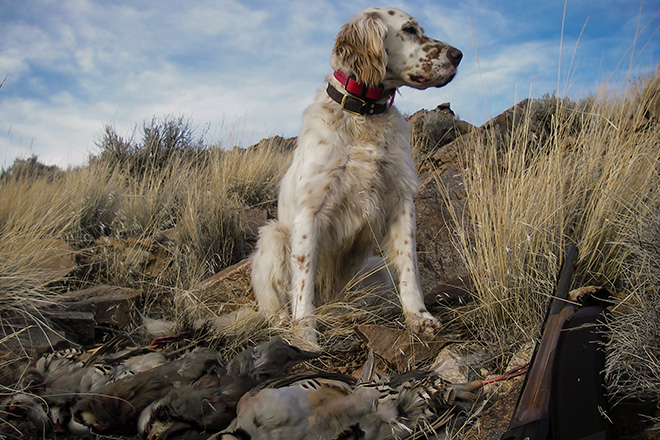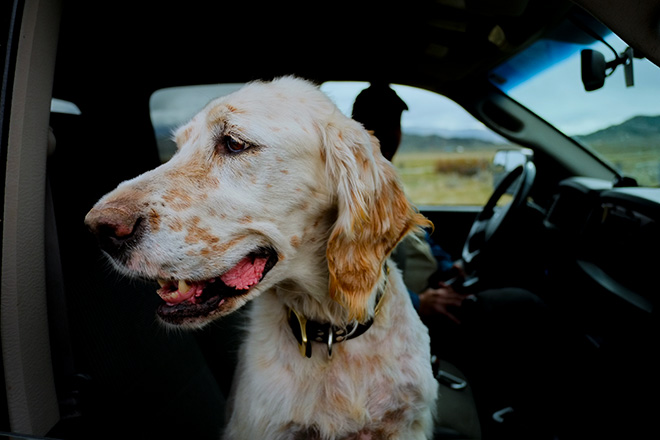Staff Photo
Some dogs find birds, and some dogs find hearts
Story By Thomas Reed
Among those who hunt the uplands season after season through dog after dog, there will be one dog. The dog. Much has been written of “the dog,” probably too much. In a lifetime, an avid uplander can have many dogs, all with varying degrees of innate talent, aside from the top performer.
The turn-of-the-1900s adventure writer Stewart Edward White called this dog “the super dog” and for those of us who have indeed done this long or often enough, there can emerge an endless quest to find another, or at least to compare all subsequent canine partners to that super dog. Entire books have been written about an author’s super dog, books that quickly make their way to the seldom-dusted rare book aisle. This work can read like one long brag and as a Western kid who was raised on dry humor and humility, there are few sinners as insufferable as the trumpeter.
There’s a problem with measuring individuals — human or canine — against an ideal. Just as no love will ever measure up to a lost love or a first love, few things in this life are ever just exactly the same. Some hunters spend their whole lives looking for their next super dog, overlooking the qualities of their really good — even great — dogs, as if the only thing that matters is the field and autumn and as if most of a year is just prep for the four months when the sun tilts away from the land. Dogs are brief and deserve better than to be made even briefer by only enjoying their company one season of four, kenneled and confined and pulled out like a summer lawnmower. Others have that super dog, lose it, and maybe never go hunting again. Ever.
Which brings us to Sage. She was not my super dog — I’ve been fortunate enough to have had two of them — but maybe she should have been or maybe she was. At least some of this is in the eye of the beholder and those of us who behold can be prone to bad eyesight.
Sage has been gone a long time but I started thinking about her again when a friend of mine, who has partnered with pointers of the European fuzzy-faced variety, wrote to me that he was going to try to convince his wife that the next dog should be a setter despite their rather unfortunate tendency to liberally varnish every indoor surface with setter hair. Sage — dead and buried almost a decade — was not the reason he was headed that direction after having two nice pointers of the other breed, but she was the reason he had pointers at all, for before his own dogs came along, he had the occasion to hunt with me often, and often behind Sage. She put him on the pointer path and a decade later, after his Griffs were maturing to old age, it came full circle back to setters. This came after we’d spent a long weekend hunting chukar and I was boasting of my so-called super dog, in full defiance of my humble upbringing. “She’s better than Sage.”
“That’s saying something,” he said.
Those words and the note made me realize that Sage, though perhaps not holding the talent title, was in fact the most influential dog I have ever owned, an ambassador spreading setter love across the wide land.
Sage spent most of her life overshadowed by two big male setters, Hank and Echo, and when a friend died and I was willed his big male, Duke, Sage probably felt a bit like a female executive in a 1980s-era office. But she nevertheless stood out.
I think the first time I really noticed it was when I went to visit my friend, the outdoor writer Greg McReynolds and his wife Denise, in New Mexico. Bird season had come to its inevitably sad cold end in Montana, but border quail called us south. What’s more, Montana has damned few, if any, places where a fella with a “spice-tooth” can get a decent meal of Mexican food. New Mexico on the other hand, starting at the Colorado line, is a place where you can dive in.
 Staff Photo
Staff Photo
McReynolds had a fine springer in her prime but he took a look at my pack of horizon-busting setters and decided to leave her at home. This was probably a good move since my bird dogs were all of the same Old Hemlock lineage favored by the author Jim Harrison, of which he wrote: “When cynics say that our dogs are ‘too far out’ we’ve learned to give a pat answer, ‘That must be where the birds are.’ The possible downside to this strain of setters is that the owner must be in fairly good walking shape. Though of serene dispositions these dogs don’t care if you have a sore foot or a hangover.”
Sage was a smallish specimen of this line and she ate up the horizon as did her boys. One of the hazards of being a dog lover and having a pack is finding the time to exercise all four sufficiently, even in a week’s hunt. So you take to running them all at once and this can make you a bit twitchy to say the least, watching them as they dart in all directions like fleas on a coon hound. There’s one well-known old codger in my neck of the woods who runs eight Brittanies all at once. I cannot imagine doing that. But at that time, all four of mine oddly worked pretty well together. I have several photos of the pack pointing all at once. I’ve since gone back to a pair, probably because I’m raising children and there’s only so much effervescence a thinking man can tolerate.
In most of those photos, Sage is doing the honoring. This was her forte. She honored every pointing dog in the kingdom. She honored white plastic feed tubs on the wide prairie. She honored setter-sized blocks of quartz. She honored Charolais calves out on the range. She honored every dog that ever pointed in front of her, and she kept pointing when many miscreants came along and stole the point from her. Classy.
That week, Sage worked her magic not far from the little town of Hatch — site of some of the best huevos rancheros in southern New Mexico — on scaled, Gambel’s, and Mearns’ quail. Then we got home and kicked back for a night or two at the McReynolds home in the city, pulling cactus spines from paws and digits, drinking tequila and looking for a satisfying Mexican meal. Quiet little Sage worked her wizardry on Denise. A few years later, the McReynolds clan expanded both in human and dog souls, adding children and setters to the mix. The old springer died a year or two ago and the McReynolds household is now exclusively setter.
At least a half dozen other friends who watched Sage do her thing went this direction. I cannot remember her bumping many birds in her life. She had a mystical way of handling birds on the move, the runners like pheasant and chukar. She crept like a cat. When the birds moved, she did. When the birds stopped, she did. I never was one for staunch-until-released probably because I like the knife-in-the-teeth nature of hunting those feral running bastards, looking inside one’s self for just another puff of gas to go up the hill, sore foot or hangover be damned. Hunting with a cautious creeper like Sage was deadly.
 Staff Photo
Staff Photo
So those folks all got pointers after hunting with Sage. Some got other breeds, but most went full English setter. This is not to say that this is the best breed — far from it — but it is the breed for me. She was not always perfect in the field, nor in camp. She was a sometime retriever whose few retrieves are as memorable as July snows in Montana. She was not always a class act. In a cold November pheasant camp on the Yellowstone River one year, she came galloping back into petting-range completely covered in just exactly the worst kind of manure a dog can roll in and she got an unexpected bath in frigid river water that night. She was overshadowed by her canine partners, overlooked even by me, and yet she did it her own way, right up to the end.
At 13, I saw the glint go out of her, the breathing shallow, and I took her into my vet whose x-rays revealed the smoke of cancer in her lungs. In the fall of that year, I took her to South Dakota, where she slogged into thirty acres of cattails and would not come out until every rooster left. It was her last hunt.
That April, she followed me upstairs to my office one morning and laid by my desk while I wrote all day long. In the evening, she staggered to her feet and laid down in front of the woodstove. It was winter again, snow blowing up against the west window, and I stoked the fire and I knew the time was upon us. In the morning, I told my wife, we will need to take her in. Since that time, I’ve watched the air go out of many of these big-lunged wind-drinkers and it is almost like watching frost evaporate from an autumn windshield. They just disappear. I got up several times in the night to check on her and Sage was still breathing, but no longer did she acknowledge my hand on her coat with a tail thump. At three in the morning, I rose and she was gone and I woke my wife and we poured shots of good Kentucky bourbon and drank toasts to the setter ambassador creeping her way over the far and final ridgeline.
Thomas Reed is the author of several books, including Give Me Mountains For My Horses. He lives with his family on a small ranch outside Pony, Montana.
This story originally appeared in the 2022 Summer Issue of the Quail Forever Journal. If you enjoyed it and would like to be the first to read more great upland content like this, become a member today!